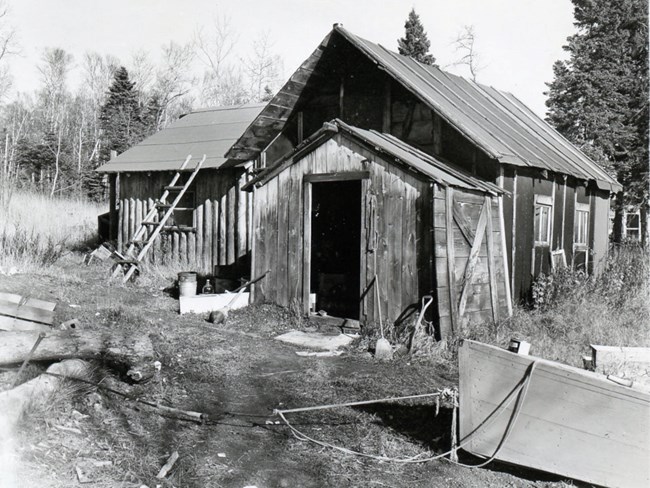Last updated: February 16, 2021
Article
Hay Bay Fisheries

National Visual Inventory Cards 50-011
History
Tucked into the western shore of Siskiwit Bay is a long, narrow cove that was home to several fishing camps including Sivert Anderson, Ed Kvalvick, Albert Bjorvek, and John T. Skadberg. Known as Hay Bay, the well-protected cove extends from Hay Bay Point to the confluence of Siskiwit River at the south end of the bay. The Kvalvicks lived across the bay from the Skadbergs, who were the last ones to use the area, which the American Fur Company first used as a fish camp in the 1830s. Everyone who lived there later also used their places as fishing camps.
Informants' descriptions of the area include the approximate 12 miles to the headwaters of the river, the middle grounds of Siskiwit Bay as bounded along a line from Point Houghton to Rabbit Island (also known as Long Island), and then to the squared-off point on the main island known as Spruce Point. These boundaries reflect the traditional fishing grounds of John Skadberg who came to Hay Bay at a time when the area was crowded with other Scandinavian fishermen. As fishermen maneuvered for fishing areas, Skadberg shifted from Malone Bay south into Siskiwit Bay and settled on Finn Point, a spur on the west shore of Hay Bay near the south end. Here, he built a one-room cabin that, over the years, grew with his family.
As another Scandinavian fish camp, the primary use of Hay Bay was as a residential base from which to fish. The Skadberg family, however, found a variety of things to do including fishing for brook trout in the river and lake trout in the bay, picking blueberries, swimming in the shallow water where the bottom was sandy, and picking agates on the beaches. Swimming was a particular treat since the weather tends to be warmer in the bay than at Fisherman's Home.
As a long, protected bay, Hay Bay provided a home, a safe haven from storms. The lack of waves reduced dock maintenance and the surrounding hills kept the winds down. While most fishing families returned to the Minnesota North Shore in the winter, the Skadberg family lived at Hay Bay year round until 1943. The area provided shelter for a residence, camping, and 4th of July celebrations. Food was bountiful in the form of game, foraging, and recreational fishing in the river and lake.
Large open areas, now overgrown, not only afforded room for the fish camp but also for the big 4th of July celebrations when fishing families gathered for potato sack races, baseball, and picnics. At the Skadberg camp, trees were planted to line the trail from the house to the fish house. Those at home had a good view of the fish house so they knew when the fishermen returned. A small treehouse afforded the children additional views of the bay and the returning fishermen.
Hay Bay is connected to Wright's Island, Fisherman's Home, Little Boat Harbor, and Rock Harbor through social relationships and water routes. The families at these locations helped each other as the need arose, shared food and fishing boundaries, and spent 4th of July celebrations together. The Holte family at Wright's Island, being the closest, was the most visited of these connected places.
